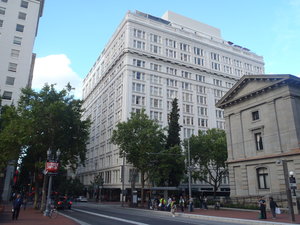Advertisement
Published: April 10th 2012

 Downtown Portland
Downtown Portland
View of downtown Portland on the way to the Portland Art Museum. The big building is the former Meier and Frank department store.I needed a dose of culture today after all that time in the woods, so I spent the day at the
Portland Art Museum, yet another regional art museum.
Like the best of them (see
The Fountain of Creativity), it focuses on a few strengths.
For this museum, those strengths are regional art, Northwest Native American art, and modern art.
I enjoyed all three.
Pacific Northwest Art
The
regional art started with landscapes from the 1800s.
Nearly all of them were some variant of the Hudson River School.
Artists treated the landscapes of the Pacific Northwest as a pure spiritual counterpart to the industrial grime of eastern cities, and the paintings reflect this.
The highlight of this section is a series of paintings of Mount Hood, an icon to Portland residents (see
Urban Wilderness) including a
famous version by
Albert Bierstadt.
The next part focuses on a group of artists called the “
Portland school”.
They all trained in Portland in the 1930s.
The style is described by the labels as modernism with Native American motifs.
I personally found it all rather mushy, which even the labels acknowledge.
The school was more about people working together

 Portland Museum of Art
Portland Museum of Art
Brushstrokes by Roy Litchensteinthat shared ideas rather than a uniform way of painting.
Carl Morris was the most famous member.
The art ranged from cubist landscapes to animal pictures with Expressionist elements, and some portraits.
The last part of this section covered contemporary art from the region.
It filled three whole rooms, which is a huge amount for this subject (see
Big Architecture in a Small City).
Like all contemporary art, the work ranged all over the place from glass bowls made by
David Chihuly to precisely constructed abstract canvases by
Lucinda Parker to symbolic figure paintings on glass by
Gregory Grenon.
Northwest
Native American art covers the many tribes in the region.
The section is highly unusual in that it was curated by representatives from the tribes themselves.
It has the carved totem poles for which the region is famous, along with beaded clothing and ceremonial masks.
Many of the tribes lived by fishing and whaling, so these animals show up repeatedly in their art.
One of the masks is a blue and white bird with an elongated beak.
NFL fans will find it unusually familiar, because the
Seattle Seahawks appropriated the design for their logo.
Just outside

 Willamette Valley
Willamette Valley
On the road through the Willamette Valley south of Portlandthe entrance sits Artifact Panel by
William Morris, a precisely laid out display of arrowheads and other small artifacts from the tribes.
Modern Art in Portland
Modern art at this museum takes up an entire building.
The art is mostly European until 1945, then international.
It is laid out mostly chronologically.
The first part is Impressionism, highlighted by one of Monet’s
water lily paintings that is nearly abstract.
Next up is
post-impressionism with the usual suspects of Cezanne, Van Gogh, and Gauguin.
The museum has very little cubism, mostly by lesser names.
The collection really shines with post-war art.
Abstract expressionism appears, of course, leading into
color field painting,
pop art, and
minimalism.
All of these have lots of examples; I really enjoyed this section.
Most of the big names appear, including
Joseph Albers,
Mark Rothko, and
Roy Lichtenstein.
The last artist is represented by a sculpture of paint brushstrokes instead of the usual paintings.
The top floor was all contemporary work which, like its regional counterpart, ranged all over the place.
Two examples are Greed by
Sue Coe, a surrealistic symbolic painting of society torn apart by materialism, and Clem’s Gift by
Kenneth Noland, an abstract investigation of color combinations.

 Mount Hood
Mount Hood
An iconic sight in northwest Oregon, Mount Hood from the Willamette Valley.Oddly enough, very little multimedia work appeared even though it is a big part of contemporary art practice.
The rest of the museum was very typical for regional museums, a little bit of a lot of different types of art.
This layout always leaves me wanting more.
American Art before 1940 was included in the American Art section rather than the modern art works for some reason.
This art had a pretty good selection, including American Impressionist landscapes from
Childe Hassam and Social Scene paintings of African American life in the Depression by
Jacob Lawrence.
After the museum, I had a drive into the Willamette Valley.
My target was a state park in the foothills on the edge of the valley.
The valley is covered in farms and wineries.
Instead of going straight as I expected, the road constantly curved.
In farming country, roads tend to be straight as an arrow between fields.
I’m beginning to think the designers did it deliberately, to encourage visitors to go somewhere else!
The road eventually hit foothills and then real hills.
One of these gave an

 Portland Museum of Art
Portland Museum of Art
Eye of Orion by Manuel Izquierdoincredible view of the surrounding area, with Mount Hood perfectly framed on the horizon.
Advertisement
Tot: 0.331s; Tpl: 0.011s; cc: 35; qc: 109; dbt: 0.2264s; 1; m:domysql w:travelblog (10.17.0.13); sld: 1;
; mem: 1.4mb







